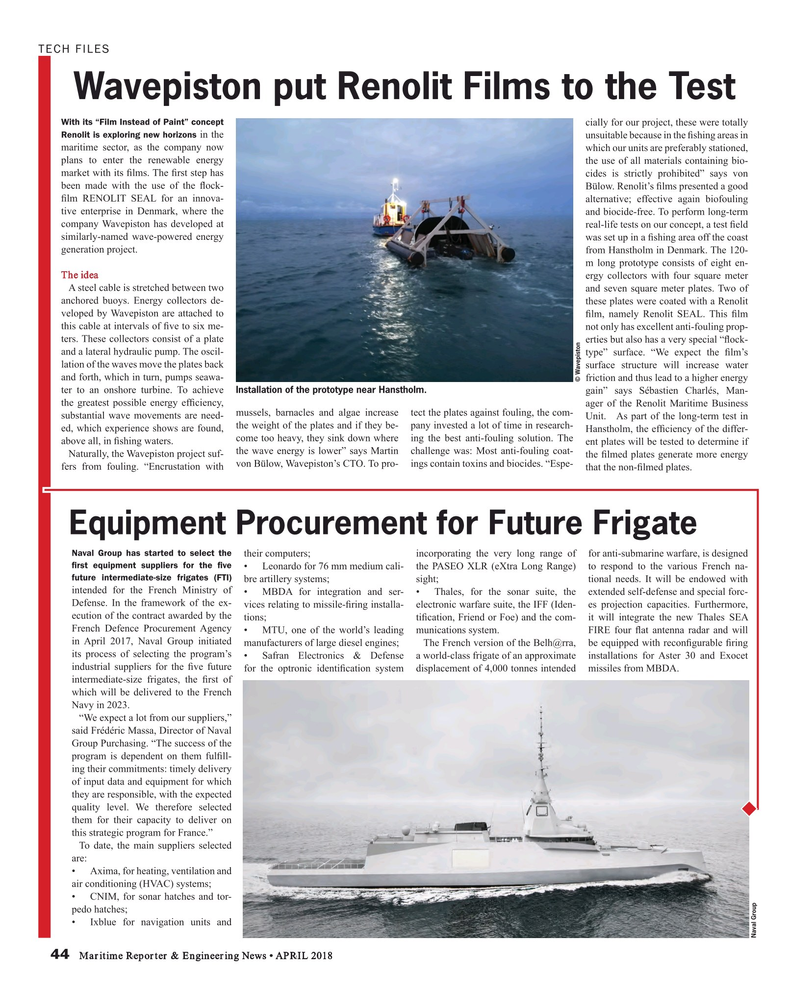
Page 44: of Maritime Reporter Magazine (April 2018)
Offshore Energy Annual
Read this page in Pdf, Flash or Html5 edition of April 2018 Maritime Reporter Magazine
TECH FILES
Wavepiston put Renolit Films to the Test
With its “Film Instead of Paint” concept cially for our project, these were totally in the unsuitable because in the ? shing areas in
Renolit is exploring new horizons maritime sector, as the company now which our units are preferably stationed, plans to enter the renewable energy the use of all materials containing bio- market with its ? lms. The ? rst step has cides is strictly prohibited” says von been made with the use of the ? ock- Bülow. Renolit’s ? lms presented a good ? lm RENOLIT SEAL for an innova- alternative; effective again biofouling tive enterprise in Denmark, where the and biocide-free. To perform long-term company Wavepiston has developed at real-life tests on our concept, a test ? eld similarly-named wave-powered energy was set up in a ? shing area off the coast generation project. from Hanstholm in Denmark. The 120- m long prototype consists of eight en-
The idea ergy collectors with four square meter
A steel cable is stretched between two and seven square meter plates. Two of anchored buoys. Energy collectors de- these plates were coated with a Renolit veloped by Wavepiston are attached to ? lm, namely Renolit SEAL. This ? lm this cable at intervals of ? ve to six me- not only has excellent anti-fouling prop- ters. These collectors consist of a plate erties but also has a very special “? ock- and a lateral hydraulic pump. The oscil- type” surface. “We expect the ? lm’s lation of the waves move the plates back surface structure will increase water and forth, which in turn, pumps seawa- friction and thus lead to a higher energy © Wavepiston
Installation of the prototype near Hanstholm.
ter to an onshore turbine. To achieve gain” says Sébastien Charlés, Man- the greatest possible energy ef? ciency, ager of the Renolit Maritime Business mussels, barnacles and algae increase tect the plates against fouling, the com- substantial wave movements are need- Unit. As part of the long-term test in ed, which experience shows are found, the weight of the plates and if they be- pany invested a lot of time in research-
Hanstholm, the ef? ciency of the differ- above all, in ? shing waters. come too heavy, they sink down where ing the best anti-fouling solution. The ent plates will be tested to determine if the wave energy is lower” says Martin challenge was: Most anti-fouling coat-
Naturally, the Wavepiston project suf- the ? lmed plates generate more energy fers from fouling. “Encrustation with von Bülow, Wavepiston’s CTO. To pro- ings contain toxins and biocides. “Espe- that the non-? lmed plates.
Equipment Procurement for Future Frigate
Naval Group has started to select the their computers; incorporating the very long range of for anti-submarine warfare, is designed ? rst equipment suppliers for the ? ve • Leonardo for 76 mm medium cali- the PASEO XLR (eXtra Long Range) to respond to the various French na- future intermediate-size frigates (FTI) bre artillery systems; sight; tional needs. It will be endowed with intended for the French Ministry of • MBDA for integration and ser- • Thales, for the sonar suite, the extended self-defense and special forc-
Defense. In the framework of the ex- vices relating to missile-? ring installa- electronic warfare suite, the IFF (Iden- es projection capacities. Furthermore, ecution of the contract awarded by the tions; ti? cation, Friend or Foe) and the com- it will integrate the new Thales SEA
French Defence Procurement Agency • MTU, one of the world’s leading munications system. FIRE four ? at antenna radar and will in April 2017, Naval Group initiated manufacturers of large diesel engines; The French version of the Belh@rra, be equipped with recon? gurable ? ring its process of selecting the program’s • Safran Electronics & Defense a world-class frigate of an approximate installations for Aster 30 and Exocet industrial suppliers for the ? ve future for the optronic identi? cation system displacement of 4,000 tonnes intended missiles from MBDA.
intermediate-size frigates, the ? rst of which will be delivered to the French
Navy in 2023.
“We expect a lot from our suppliers,” said Frédéric Massa, Director of Naval
Group Purchasing. “The success of the program is dependent on them ful? ll- ing their commitments: timely delivery of input data and equipment for which they are responsible, with the expected quality level. We therefore selected them for their capacity to deliver on this strategic program for France.”
To date, the main suppliers selected are: • Axima, for heating, ventilation and air conditioning (HVAC) systems; • CNIM, for sonar hatches and tor- pedo hatches; • Ixblue for navigation units and
Naval Group 44 Maritime Reporter & Engineering News • APRIL 2018
MR #4 (42-49).indd 44 MR #4 (42-49).indd 44 4/6/2018 9:19:31 AM4/6/2018 9:19:31 AM

 43
43

 45
45
